
This special release highlights the vital statistics on registered marriages in Marinduque Province for the period January to December 2023. Compiled by the Provincial Statistical Office of Marinduque, in collaboration with local civil registry offices, this report offers a detailed overview of marriage trends and patterns within the province.
The data presented reflects the commitment to maintaining accurate and comprehensive records, providing essential insights for policymakers, researchers, and local stakeholders. These statistics serve as a foundation for informed decision-making and the development of programs that address the evolving needs of Marinduque's communities. By understanding marriage trends, this report contributes to the broader goal of fostering inclusive and sustainable growth across the province.
Registered Marriages by Municipality in Marinduque
In 2023, a total of 1,045 marriages were officially registered across the local civil registry offices in the province of Marinduque. Among its six municipalities, Santa Cruz emerged as the municipality with the highest number of registered marriages, recording 270 cases. This figure represents 25.8 percent of the overall total for the province, highlighting its status as a significant contributor to the province's marriage statistics. Conversely, Gasan reported the fewest registered marriages, with only 128 cases, accounting for a mere 12.2 percent of the provincial total.
Out of the total number of registered marriages in the Philippines, the number recorded in Marinduque accounts for only 0.3 percent of the national total, emphasizing its modest share in the broader context of the country’s marriage statistics.
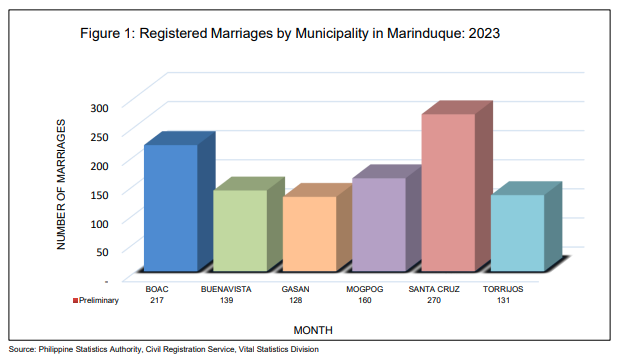
Registered Marriages by Ceremony
Marriage is a significant milestone in a couple's life, often celebrated in a manner reflective of their personal preferences, beliefs, and traditions. As shown in Figure 2, civil ceremonies emerged as the most preferred type among Filipinos, with a total of 177,627 recorded occurrences, accounting for 42.9 percent of all marriages. This preference underscores thepopularity of simpler and more accessible wedding options. On the other hand, tribalceremonies, which registered only 2,830 occurrences, accounted for a mere 0.7 percent. Thishighlights the rarity of traditional tribal weddings in the context of modern marriage trends in the Philippines. These figures provide valuable insights into the evolving preferences of couples in the country, reflecting the diverse ways in which Filipinos celebrate this once-in-alifetime event.
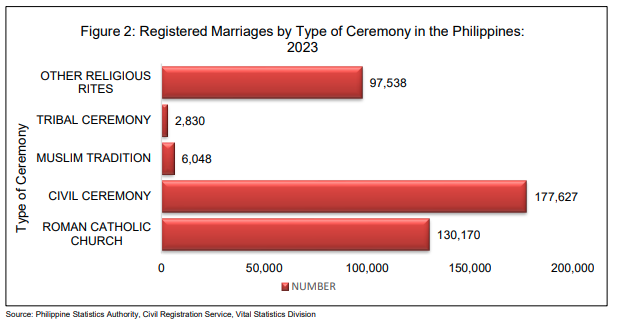
Registered Marriages by Age Group
According to the data presented in Figure 3, the age group 25–29 stands out as the most common age for marriage among both males and females in the Philippines. This age group records the highest number of registered marriages for men, indicating that a significant portion of males decide to marry during this period. Similarly, females also show the highest number of registered marriages in the 25–29 age group, suggesting that this is the preferred age for marriage for women as well.
In contrast, the data reveals that there were individuals who got married under 15 years of age, with more women entering married life at this very young age.
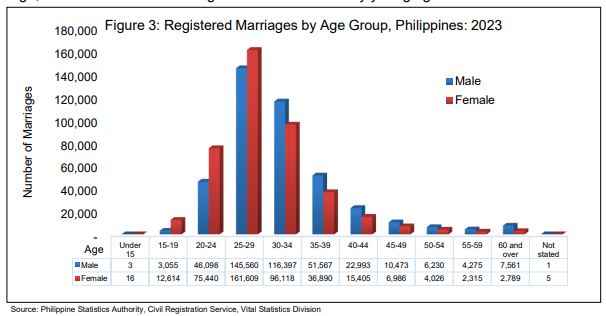
Registration Status of Registered Marriages
Out of the total number of registered marriages in the Philippines, 96.1 percent, equivalent to 398,047 marriages, were registered within the prescribed 30-day reglementary period. These registrations are categorized as timely, indicating compliance with the mandated timeline for filing. On the other hand, 3.9 percent of the total, or 16,166 marriages, were registered beyond the 30-day reglementary period. These are classified as delayed registrations, reflecting instances where the filing of marriage records occurred outside the required timeframe.
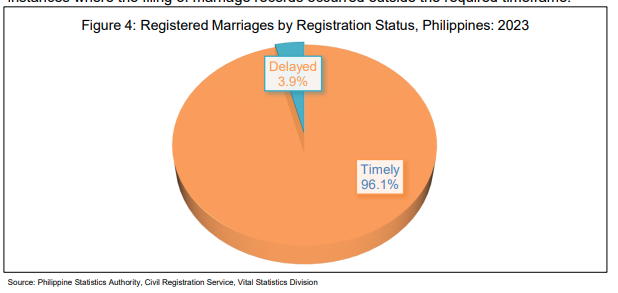
Registered Marriages by Citizenship
In a detailed analysis of the top 10 nationalities of foreign nationals married in the Philippines, the data reveals a significant trend. Filipino citizens, as expected, make up the largest group of those involved in marriages within the country. Following them, Americans constitute the second-largest foreign nationality among those married to Filipinos. Specifically, 4,579 American males have married in the Philippines, showcasing a notable preference among Filipino women for partners. On the other hand, 307 American females have entered marriages, reflecting a distinct trend in the choices of American women.
In addition to American nationals, Indian citizens also form an important group in this context. Additionally, Indian nationals stand out as the 10th largest group, with a total of 409 Indian males exchanging I do’s in the local scene, further indicating the growing presence of Indian nationals in the Philippines. Meanwhile, 49 Indian females have also married in the Philippines, suggesting a smaller yet notable connection between the two countries' nationals.
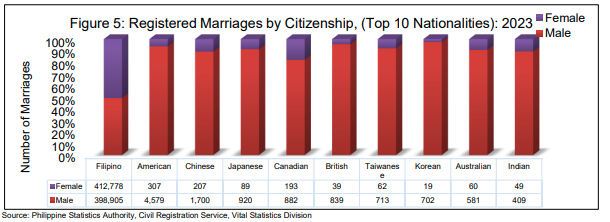
The collaboration between Marinduque's Local Civil Registry Offices and the PSA Marinduque Provincial Statistical Office is essential in ensuring accurate and comprehensive records of registered marriages in 2023. This meticulous documentation of marriage events demonstrates a strong commitment to preserving reliable demographic information. Such data is crucial for making informed decisions, planning public health initiatives, and shaping effective policies, all of which contribute to better governance and an enhanced quality of life for the people of Marinduque. This report highlights the importance of coordinated efforts and systematic data collection by government agencies in monitoring and analyzing registered marriages in the province.

(SGD)GEMMA N. OPIS
Chief Statistical Specialist
PSA PSO Marinduque
GNO/ASLL

